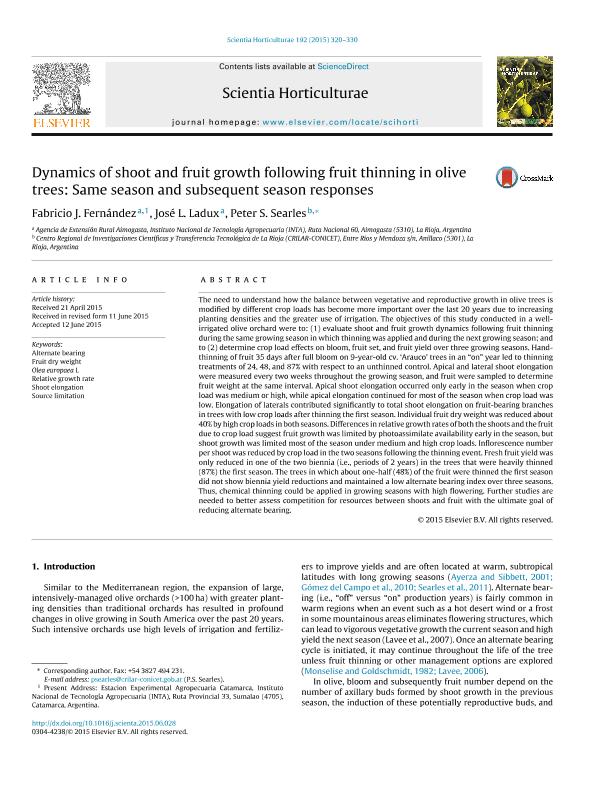Mostrar el registro sencillo del ítem
dc.contributor.author
Fernández, Fabricio
dc.contributor.author
Ladux, Jose Luis
dc.contributor.author
Searles, Peter Stoughton

dc.date.available
2018-04-10T15:26:23Z
dc.date.issued
2015-08
dc.identifier.citation
Fernández, Fabricio; Ladux, Jose Luis; Searles, Peter Stoughton; Dynamics of shoot and fruit growth following fruit thinning in olive trees: Same season and subsequent season responses; Elsevier Science; Scientia Horticulturae; 192; 8-2015; 320-330
dc.identifier.issn
0304-4238
dc.identifier.uri
http://hdl.handle.net/11336/41498
dc.description.abstract
The need to understand how the balance between vegetative and reproductive growth in olive trees is modified by different crop loads has become more important over the last 20 years due to increasing planting densities and the greater use of irrigation. The objectives of this study conducted in a well-irrigated olive orchard were to: 1) evaluate shoot and fruit growth dynamics following fruit thinning during the same growing season in which thinning was applied and during the next growing season; and to 2) determine crop load effects on bloom, fruit set, and fruit yield over three growing seasons. Hand-thinning of fruit 35 days after full bloom on 9-year-old cv. ´Arauco´ trees in an "on" year led to thinning treatments of 24, 48, and 87% with respect to an unthinned control. Apical and lateral shoot elongation were measured every two weeks throughout the growing season, and fruit were sampled to determine fruit weight at the same interval. Apical shoot elongation occurred only early in the season when crop load was medium or high, while apical elongation continued for most of the season when crop load was low. Elongation of laterals contributed significantly to total shoot elongation on fruit-bearing branches in trees with low crop loads after thinning the first season. Individual fruit dry weight was reduced about 40% by high crop loads in both seasons. Differences in relative growth rates of both the shoots and the fruit due to crop load suggest fruit growth was limited by photoassimilate availability early in the season, but shoot growth was limited most of the season under medium and high crop loads. Inflorescence number per shoot was reduced by crop load in the two seasons following the thinning event. Fresh fruit yield was only reduced in one of the two biennia (i.e., periods of 2 years) in the trees that were heavily thinned (87%) the first season. The trees in which about one-half (48%) of the fruit were thinned the first season did not show biennia yield reductions and maintained a low alternate bearing index over three seasons. Thus, chemical thinning could be applied in growing seasons with high flowering. Further studies are needed to better assess competition for resources between shoots and fruit with the ultimate goal of reducing alternate bearing.
dc.format
application/pdf
dc.language.iso
eng
dc.publisher
Elsevier Science

dc.rights
info:eu-repo/semantics/openAccess
dc.rights.uri
https://creativecommons.org/licenses/by-nc-sa/2.5/ar/
dc.subject
Alternate Bearing
dc.subject
Fruit Dry Weight
dc.subject
Olea Europaea L.
dc.subject
Relative Growth Rate
dc.subject
Shoot Elongation
dc.subject
Source Limitation
dc.subject.classification
Agricultura

dc.subject.classification
Agricultura, Silvicultura y Pesca

dc.subject.classification
CIENCIAS AGRÍCOLAS

dc.title
Dynamics of shoot and fruit growth following fruit thinning in olive trees: Same season and subsequent season responses
dc.type
info:eu-repo/semantics/article
dc.type
info:ar-repo/semantics/artículo
dc.type
info:eu-repo/semantics/publishedVersion
dc.date.updated
2018-04-10T14:20:32Z
dc.journal.volume
192
dc.journal.pagination
320-330
dc.journal.pais
Países Bajos

dc.journal.ciudad
Amsterdam
dc.description.fil
Fil: Fernández, Fabricio. Instituto Nacional de Tecnología Agropecuaria; Argentina
dc.description.fil
Fil: Ladux, Jose Luis. Instituto Nacional de Tecnología Agropecuaria; Argentina
dc.description.fil
Fil: Searles, Peter Stoughton. Consejo Nacional de Investigaciones Científicas y Técnicas. Centro Regional de Investigaciones Científicas y Transferencia Tecnológica de La Rioja. - Universidad Nacional de La Rioja. Centro Regional de Investigaciones Científicas y Transferencia Tecnológica de La Rioja. - Universidad Nacional de Catamarca. Centro Regional de Investigaciones Científicas y Transferencia Tecnológica de La Rioja. - Secretaría de Industria y Minería. Servicio Geológico Minero Argentino. Centro Regional de Investigaciones Científicas y Transferencia Tecnológica de La Rioja. - Provincia de La Rioja. Centro Regional de Investigaciones Científicas y Transferencia Tecnológica de La Rioja; Argentina
dc.journal.title
Scientia Horticulturae

dc.relation.alternativeid
info:eu-repo/semantics/altIdentifier/doi/http://dx.doi.org/10.1016/j.scienta.2015.06.028
dc.relation.alternativeid
info:eu-repo/semantics/altIdentifier/url/https://www.sciencedirect.com/science/article/pii/S0304423815300492
Archivos asociados
